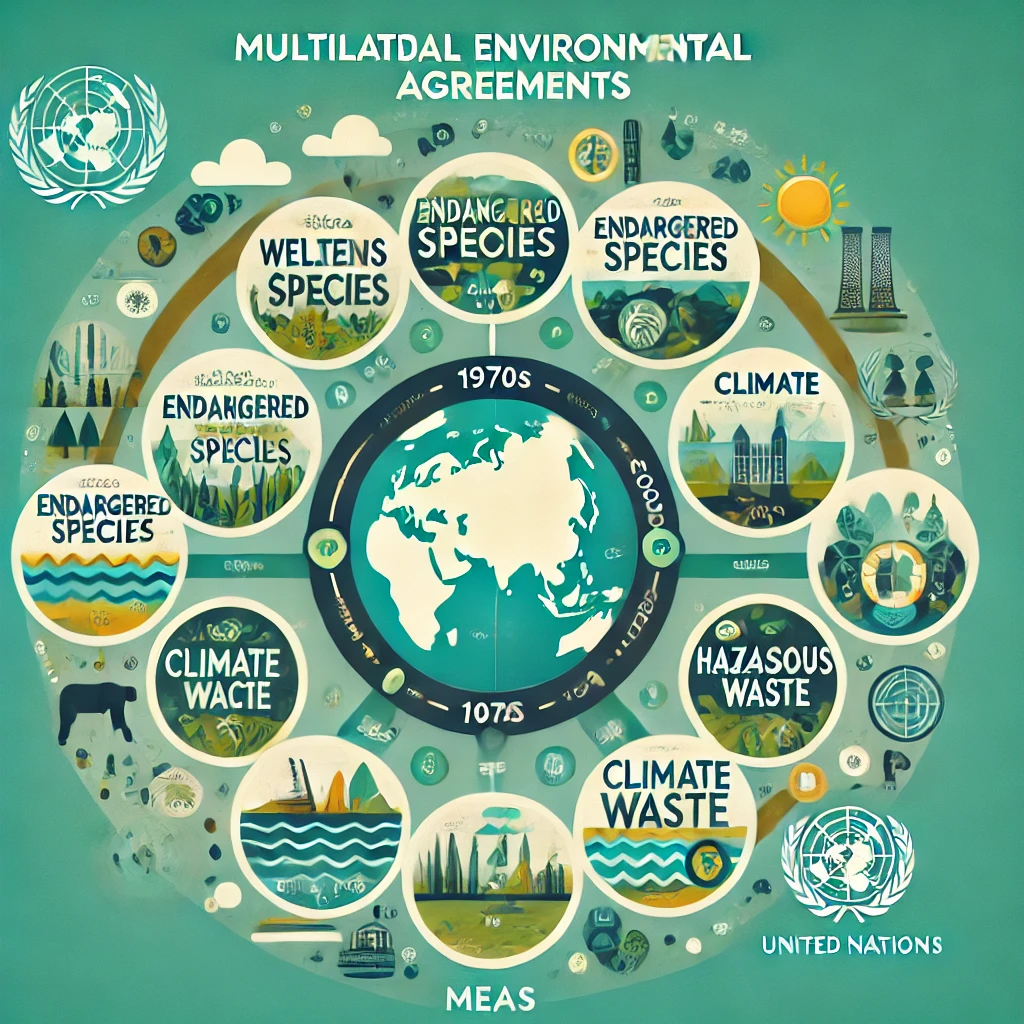Environmental challenges require global cooperation, and Multilateral Environmental Agreements (MEAs) are pivotal in addressing pressing ecological issues. These international treaties establish frameworks for collective action to protect the planet’s biodiversity, combat pollution, and ensure sustainable development. Here’s a breakdown of significant MEAs and their roles:
1970s: Foundations of Global Environmental Governance
- 1971: The Ramsar Convention on Wetlands
- Focus: Conservation and sustainable use of wetlands, recognizing their ecological importance.
- Impact: Provides guidelines for the protection of wetlands of international significance.
- 1972: Convention for the Protection of the World Cultural and Natural Heritage
- Focus: Safeguarding cultural and natural heritage sites of outstanding value.
- Example: UNESCO World Heritage Sites.
- 1973: Convention on International Trade in Endangered Species of Wild Fauna and Flora (CITES)
- Focus: Regulates international trade in endangered species to prevent extinction.
- Significance: Protects biodiversity by controlling illegal wildlife trade.
- 1973/1978: MARPOL (Convention for the Prevention of Pollution from Ships)
- Focus: Preventing marine pollution from ships due to operational or accidental discharges.
- 1979: UN/ECE Convention on Long-Range Transboundary Air Pollution (LRTAP)
- Focus: Reducing air pollution and its transboundary effects.
- Impact: Addresses acid rain and other air quality issues.
1980s: Strengthening Commitments
- 1985/1987: Vienna Convention and Montreal Protocol
- Focus: Protecting the ozone layer by phasing out ozone-depleting substances.
- Achievements: Significant recovery of the ozone layer due to global compliance.
- 1989: Basel Convention
- Focus: Regulating transboundary movements of hazardous wastes and ensuring environmentally sound disposal.
- Significance: Prevents illegal dumping of hazardous waste in developing countries.
1990s: Tackling Desertification and Climate Change
- 1992: U.N. Framework Convention on Climate Change (UNFCCC)
- Focus: Mitigating climate change by reducing greenhouse gas emissions.
- Milestones: Led to the Kyoto Protocol and the Paris Agreement.
- 1992: Convention on Biological Diversity
- Focus: Conservation of biodiversity, sustainable use of its components, and fair sharing of benefits.
- Significance: Aims to halt biodiversity loss through global cooperation.
- 1994: UN Convention to Combat Desertification
- Focus: Addressing land degradation and desertification, particularly in arid regions.
2000s: Focus on Persistent Organic Pollutants and Mercury
- 2001: The Stockholm Convention on Persistent Organic Pollutants (POPs)
- Focus: Eliminating or restricting harmful chemical substances known for their persistence in the environment.
- Impact: Targets substances like DDT and PCBs.
- 2013: Minamata Convention on Mercury
- Focus: Reducing mercury emissions and addressing its adverse effects on health and the environment.
- Significance: Aims to prevent mercury poisoning and contamination globally.
1998: Aarhus and Rotterdam Conventions
- UN/ECE Aarhus Convention
- Focus: Ensuring access to information, public participation, and justice in environmental matters.
- Rotterdam Convention
- Focus: Promoting informed consent in the trade of hazardous chemicals and pesticides.
- Importance: Strengthens transparency and accountability in international trade.
Recent Ongoing Negotiation: Treaty on High Seas
What Are the High Seas?
Definition: The high seas refer to oceanic regions that lie beyond the national jurisdiction of any single country. Typically, a nation’s jurisdiction extends up to 200 nautical miles (370 kilometers) from its coastline, within an area known as the Exclusive Economic Zone (EEZ).
Global Commons: The high seas account for approximately 64% of the ocean’s total area—around two-thirds—and are considered a part of the global commons. These areas are not owned by any nation and offer equal opportunities for all to engage in activities such as navigation, overflight, economic pursuits, scientific exploration, and the installation of undersea infrastructure like cables.
The BBNJ Agreement
Full Name: The agreement is formally known as the Agreement on the Conservation and Sustainable Use of Marine Biological Diversity of Areas Beyond National Jurisdiction.
Under UNCLOS: It is an international treaty that falls under the framework of the United Nations Convention on the Law of the Sea (UNCLOS). The BBNJ Agreement will become the third implementation treaty under UNCLOS if it enters into force, alongside:
- The 1994 Part XI Implementation Agreement (focused on mineral resource exploration and extraction in international seabed areas).
- The 1995 UN Fish Stocks Agreement (focused on the management and conservation of migratory and straddling fish stocks).
Adoption: The agreement was adopted in 2023 and will remain open for signatures for two years. It will become a legally binding international treaty 120 days after 60 countries ratify it. As of June 2024, 91 nations have signed the agreement, and eight have ratified it.
Objective: The primary goal of the BBNJ Agreement is to ensure the conservation and sustainable utilization of marine biological diversity in areas beyond national jurisdiction, both for current and future generations.
These MEAs collectively demonstrate the power of international collaboration in tackling environmental crises. As the world faces escalating challenges like climate change, biodiversity loss, and pollution, the commitment to these agreements and their continued evolution will remain crucial for a sustainable future.
Source: UNITAR

